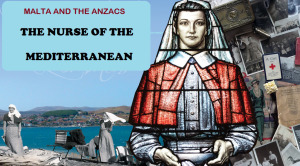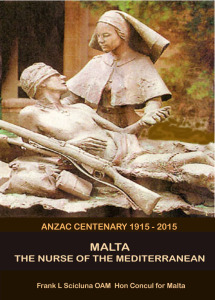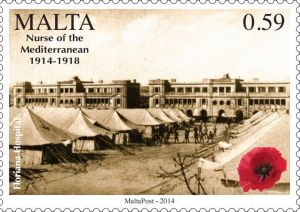MALTA AND THE ANZACS
THE NURSE OF THE MEDITERRANEAN
I was delighted to receive my copy of Malta and the Anzacs: The Nurse of the Mediterranean by Frank L Scicluna OAM. It is a quality production, hard covered and printed on 150 pages of glossy paper, with superb photographs and illustrations throughout. The introduction by His Excellency Charles Muscat, High Commissioner for Malta to Australia and New Zealand, the Foreword by Chev Charles Farrugia OAM JP, President of the RSL Maltese Sub-branch South Australia, messages from several MPs and many others all pay tribute to the important role this book plays in commemorating Malta’s contribution during World War I, on the hundredth anniversary of the ANZAC tradition. Around 80,000 wounded soldiers owe their lives to the care they received in Malta. 276 never made it home and found their permanent resting place in Malta. The book describes the events of World War I, the development of the ANZAC tradition, and some of the people involved through diaries, firsthand accounts and old photographs. Although Malta did not play a direct part in fighting, the Maltese were active in repairing ships, as well as crewing them. Over 600 Maltese were killed, mostly at sea. The number of Maltese serving with the Australians is unknown but it is estimated that 15000 served in some capacity in the army, including 7,000 in the Maltese Labour Corps, 1000 of whom unloaded ships at Anzac Cove. 27 hospitals were established in Malta, catering for up to 135,000 sick and wounded, including 20,000 ANZACs. Frank describes them in detail and also describes some of the personalities involved, and the many complications they had to deal with, such as leprosy and malaria, dysentery, typhoid and trench fever. An interesting section in the book deals with hospital ships during the war; another on the prisoners of war held in Malta Frank lists details of the 276 ANZACs buried in Maltese war graves, which are cared for by the Commonwealth War Graves Commission. During World War I, 2692 Australian nurses volunteered for service. Twenty-five died on active service; some are buried in Malta and are remembered, as are 7 known Maltese ANZACs who were killed, and a number of Maltese migrants to Australia who served in the armed forces. The book shows Maltese stamps commemorating WWI as well as the bronze memorial plaque, known as “Dead Man’s Penny”, which was issued to the families of those who died. Photographs and descriptions of the military cemeteries in Malta, including the Turkish cemetery, are given, as well as a memorial to the 68 Japanese sailors buried at Kalkara Naval cemetery in Malta. Frank describes the now dilapidated Australia Hall, earmarked for conservation, and details the inauguration celebrations of the ANZAC memorial in the Argotti gardens in Floriana. He concludes with the anthems of Australia, New Zealand and Malta. What a thoroughly enjoyable, detailed and informative book this is; a must for your library! MALTA AND THE ANZAC CONNECTION ANZAC Day is commemorated on the anniversary of the fateful pre-dawn landing of the Australian and New Zealand Army Corps (ANZAC) on the Gallipoli peninsula in Turkey, on 25 April 1915. The battle by Allied soldiers to capture and hold the Gallipoli Peninsula was one of the hardest fought, but ultimately futile, campaigns of the First World War. As the troops landed on the beaches of the Peninsula, they were cut down by sustained and concentrated machine-gun fire. In the nine—month campaign that was to follow, both sides would suffer a disastrous loss of life. Of the 51,472 members of the Australian lmperial Forces — from a total Australian population of just five million — to serve at Gallipoli, 8,141 were killed during the campaign. As many as 66,000 Turkish lives are believed to have been lost. This heavy toll of dead and wounded carved deeply into the psyche of the of Australia and New and since the first anniversary of the 25 April has been observed in both countries of solemn remembrance. The significance of Day has only over the years as remembers those who have laid down their lives in the many conflicts in which have served since the Gallipoli campaign. Recognizing the association stretching back to the Gallipoli campaign between the AN ZACs and Malta, the Australian High Commission has, for many years, observed ANZAC Day with a Commemoration at Pieta Military Cemetery, one of five cemeteries in Malta in which ANZAC troops are buried. Shared duty has long brought the two nations together. There were six Maltese members of the 7th Australian Brigade which earned fame for its part in the Gallipoli landing. History remembers Malta as the ‘Nurse of the Mediterranean’, with 57,950 of those wounded in the Dardanelles campaign, including several thousand ANZACs, evacuated to Malta for treatment. For some the island was also to become their final resting place – there are 229 Australian and 79 New Zealand war graves in Malta. Today, 100 years after that first ANZAC Day, there are no longer any living survivors of the Gallipoli campaign, but the legacy and traditions forged on those forbidding shores are an ever present memorial to those who served, suffered, and sacrificed their tomorrow for our today.~~~~~~~~~~~~~~~~~~~~~~~~~~~~~~~~~~~~~~~~~~~~~~~~~~~~~~~~~~~~~~~~~
|
ANZAC CENTENARY 1914 -1918 ALL GAVE SOME – SOME GAVE ALL  We remember the sacrifice, contribution and courage of all those who were involved in the First World War and ANZAC
Between 2014 and 2018, Australia and New Zealand commemorate the Anzac Centenary, marking 100 years since the nations’ involvement in the First World War.
The First World War was one of the most significant events of the 20th Century, claiming the lives of more than 16 million people across the globe.
Even now, almost 100 year on, we are all connected to the Anzac Centenary (2014 – 2018) through our own family history, the heritage of our local communities or the lasting impact it left on generations of Australians and New Zealanders.
From the Declaration of War, to the various bloody battles and surrenders, and finally to the armistice and the global impact left in its wake, every detail has been recorded in hundreds, if not thousands, of books.
During the Anzac Centenary, we remember not only the original Anzacs who served at Gallipoli and the Western Front, but commemorate more than a century of service by Australian and New Zealand servicemen and women.
This publication, Malta, the Nurse of the Mediterranean, is a compelling account of Malta’s involvement in World War I.
Even the little island of Malta, just in the middle of the Mediterranean Sea, played an important part during the First World War so much so that it earned the title of The Nurse of the Mediterranean.
~~~~~~~~~~~~~~~~~~~~~~~~~~~~~~~~~~~~~~~~~~~~~~~~~~~~~~~~~~~~~~~~~~~~~~~~~~~~~~~~~~~~
MALTAPOST – Stamps commemorating WW1
We remember the sacrifice, contribution and courage of all those who were involved in the First World War and ANZAC
Between 2014 and 2018, Australia and New Zealand commemorate the Anzac Centenary, marking 100 years since the nations’ involvement in the First World War.
The First World War was one of the most significant events of the 20th Century, claiming the lives of more than 16 million people across the globe.
Even now, almost 100 year on, we are all connected to the Anzac Centenary (2014 – 2018) through our own family history, the heritage of our local communities or the lasting impact it left on generations of Australians and New Zealanders.
From the Declaration of War, to the various bloody battles and surrenders, and finally to the armistice and the global impact left in its wake, every detail has been recorded in hundreds, if not thousands, of books.
During the Anzac Centenary, we remember not only the original Anzacs who served at Gallipoli and the Western Front, but commemorate more than a century of service by Australian and New Zealand servicemen and women.
This publication, Malta, the Nurse of the Mediterranean, is a compelling account of Malta’s involvement in World War I.
Even the little island of Malta, just in the middle of the Mediterranean Sea, played an important part during the First World War so much so that it earned the title of The Nurse of the Mediterranean.
~~~~~~~~~~~~~~~~~~~~~~~~~~~~~~~~~~~~~~~~~~~~~~~~~~~~~~~~~~~~~~~~~~~~~~~~~~~~~~~~~~~~
MALTAPOST – Stamps commemorating WW1
The first group of 600 casualties arrived from Gallipoli on 4th of May 1915. Initially, numerous wounded men were disembarked on the quayside by Valletta’s ancient Sacra Infermeria hospital. They were then moved on to other hospitals around the Island. This activity earned Malta the title: ‘Nurse of the Mediterranean.’ The stamps carry a face value of €0.10 and €0.59 and €2.00 and portray the images of Bighi Hospital, Floriana Hospital and HMHS Rewa respectively. The stamps have been designed by Paul Psaila and are issued in sheets of 10 stamps. Each stamp measures 44mm x 31mm with a perforation of 13.9 x 14.0 (comb.), while the sheets measures 119mm x 186mm. The Malta stamps bear the Maltese Crosses watermark. Printex Limited produced the set in offset and the issue consists of 240,000 of the €0.10 stamp, 300,000 of the €0.59 and 72,000 of the €2.00. This Philatelic Issue are available for sale on the 7th of November 2014 from all Post Offices in Malta and Gozo: online at www.maltaphilately.com or by mail from the Philatelic Bureau, MaltaPost p.l.c. 305, Qormi Road, Marsa, MTP 1001; Telephone: 2596 1740, email: info@maltaphilately.com. Webmaster: Frank L Scicluna – Adelaide, Australia – Copyright 2014CONTACT: honconsul@live.com.au |


































